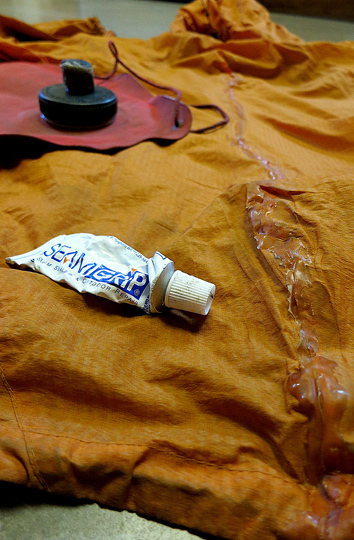
Herrington’s resized jacket and modified dromedary. [Photo] Blake Herrington
My grasp of contemporary fashion, music and even basic social trends is tenuous, at best. Yet one of 2012’s hallmarks, of which I am fully-informed, is the obsession with all things pickled. The hipster-and-home-garden-inspired craze was even skewered in a recent episode of Portlandia, with the main characters cruising Cascadia’s streets on fixies, adamantly proclaiming, “we can pickle that.” And although I appreciate the potential cost and food savings from a well-pickled veggie, my preferred method of chemical salvage revolves around a magical tube of glue, and the supremely confident proclamation, “I can Seam Grip that!”
It is said, that upon holding a hammer, everything suddenly seems like a nail. For me, when holding an open tube of Seam Grip, everything seems to be leaking, tattered, crampon-torn, in too-many pieces, insufficiently waterproof or potentially in danger of achieving any of these states. I attribute this to Seam Grip’s incredible effectiveness, as well as its alacritous tendency to harden inside the tube, rendering your $6 glue into a 3/4oz. rubber-filled sleeve. In addition to the normal uses, such as sleeping pad repair and shoe reinforcement, I’ve Seam Gripped my car (clutch pedal and broken tail light), apartment plumbing (loose shower knob) and iPod (which now doesn’t slide off a dusty dashboard). I have also cut away a thin triangle of fabric from the back of a size large jacket, and Seam Gripped the left and right halves together. It’d been a gift, so who was I to let a detail like proper sizing prevent the use of a much-needed coat? Amid various crusades to utilize every drop of adhesive from a partially-used, hence soon-to-harden tube, I’ve also found a number of seriously beneficial applications for climbers.
Spats – Despite the above-professed lack of any fashion sense, I read enough climbing magazines to realize that the cool climbers don’t wear gaiters. Do the cool climbers all have wet socks? Not if their snowy adventures have them using spats! With a pair of stretchy, softshell pants, it’s easy to keep your pant cuff low over your shoe. Tie a piece of elastic cord to the inside and outside edges of your ankles and pull this beneath your shoes’s arch. The Seam Grip comes into play when cutting the holes in your pants through which to tie the cord. Rather than tearing a hole in the fabric, which will rip, simply dab a couple one-inch circles of Seam Grip at the bottom of both legs. After these have hardened, use a hot, sharp object (tent stake + Jetboil if in the field) to puncture the pants in the middle of the Seam Grip and you’ve got a reinforced grommet for your spat.
Dromedary Bags – Carrying water in a bag has several advantages over water bottles. The volume is reduced as you drink the contents, and the weight (per fillable volume) is less than Nalgene bottles. However, the lid itself isn’t attached to the water vessel, and dropping the lid from a route would render your container useless. Use Seam Grip and a 10″ piece of 3mm cord to connect the lid to the bag. The cord can be glued directly onto (or through) the dromedary, but you will likely have to supplement your cord-to-cap connection with a bit of tape to hold things together while the glue hardens.
Pull Cords – Jacket designers insist on attaching the elastic pull cords along both sides of the hem of their products. These tend to hang directly over one’s gear loops when climbing, and frequently snag with gear and slings. Simply lay your jacket on the ground inside-out and seam grip the center of the elastic loop (or the plastic pull tab) to the inner part of your coat. Sure, this compromises quick access to one’s coat-cinching, but it also keeps your gear loops and ice clippers free of anything other than actual climbing gear.
Brake Lights – This may not technically be a climbing-related repair, but if your pre-dawn start and post-peak euphoria results in backing into a spruce tree, you’ll need to explain to your significant other that repairs are cheap and the untracked powder was worth it. Fixing a brake light yourself is a good start. For a simple crack, just clean the plastic and scuff the sides of the crack with coarse sandpaper. Apply Seam Grip and you’re done. For missing pieces of plastic, squeeze a puddle of Seam Grip onto a sheet of plastic wrap and allow it to harden into a rubbery pancake. Color this yellow or red (to match the missing plastic) with a permanent marker. Peel from the plastic and trim to fit the missing plastic and place onto your cracked tail light. You may need to use tape temporarily, and then apply Seam Grip around the edges, which will cure and hold the patch in place. This has been proven to keep a tail light functioning and dry over the course of multiple Washington winters. And despite what that spruce tree would say, the powder turns were totally worth it.
One need not embrace complete commitment to Seam Grip-ability in order to start prolonging the life of key gear and reaping the benefits of a glue-ier life. I bet some sealed-over guide tennies and a Seam Gripped windshirt would look pretty darn convincing when bumming leftovers in the Yosemite Cafeteria. And if you really score on a bunch of free food? Forget the pickling and invite some friends over. The relish packets are already free.